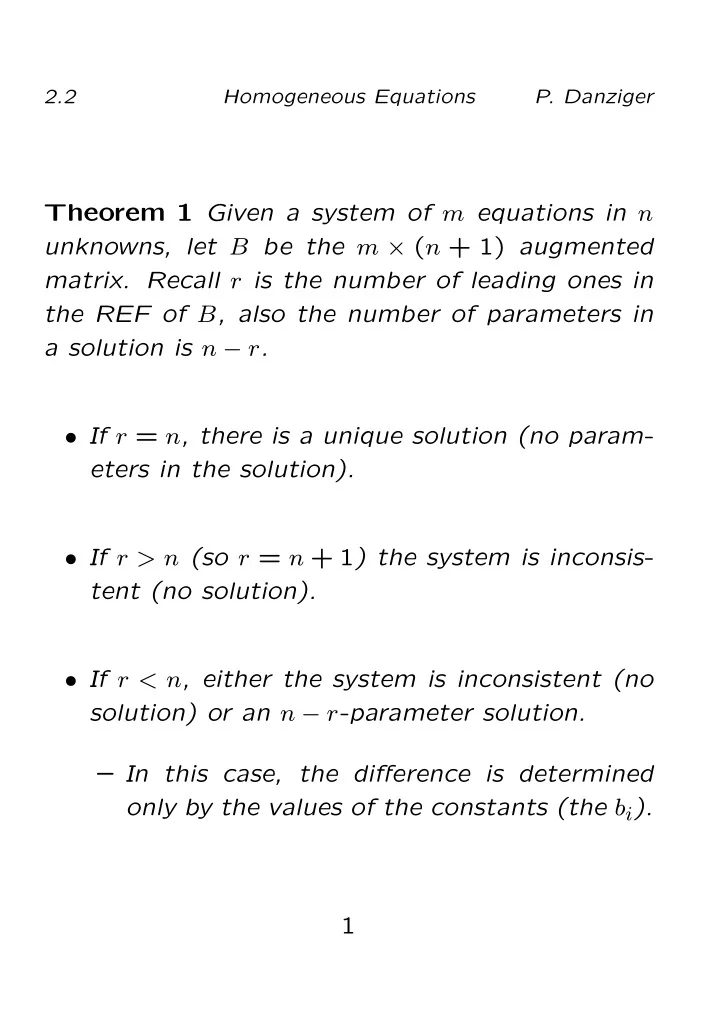

2.2 Homogeneous Equations P. Danziger Theorem 1 Given a system of m equations in n unknowns, let B be the m × ( n + 1) augmented matrix. Recall r is the number of leading ones in the REF of B , also the number of parameters in a solution is n − r . • If r = n , there is a unique solution (no param- eters in the solution). • If r > n (so r = n + 1 ) the system is inconsis- tent (no solution). • If r < n , either the system is inconsistent (no solution) or an n − r -parameter solution. – In this case, the difference is determined only by the values of the constants (the b i ). 1
2.2 Homogeneous Equations P. Danziger Homogeneous Systems Given a system of m equations in n unknowns a 11 x 1 + a 12 x 2 + . . . + a 1 n x n = b 1 a 21 x 1 + a 22 x 2 + . . . + a 2 n x n = b 2 . . . . . . a m 1 x 1 + a m 2 x 2 + . . . + a mn x n = b m If all of the constant terms are zero, i.e. b i = 0 for i = 1 , . . . m the corresponding system of equa- tions is called a homogeneous system system of equations . Example 2 + 2 x 2 3 x 3 + = 0 x 1 x 4 − + 3 x 4 = 0 x 2 x 3 − + + + = 0 x 1 x 2 x 3 x 4 2
2.2 Homogeneous Equations P. Danziger A homogeneous system of equations always has the solution x 1 = x 2 = . . . = x n = 0 This is called the Trivial Solution . Since a homogeneous system always has a solution (the trivial solution), it can never be inconsistent. Thus a homogeneous system of equations always either has a unique solution or an infinite number of solutions. Theorem 3 If n > m then a homogeneous system of equations has infinitely many solutions. 3
2.2 Homogeneous Equations P. Danziger Example 4 1. + + = 0 x 1 x 2 x 3 + 2 x 2 + = 0 x 1 x 3 + + 2 x 3 = 0 x 1 x 2 1 1 1 0 R 2 R 2 − R 1 → 1 2 1 0 R 3 R 3 − R 1 → 1 1 2 0 1 1 1 0 0 1 1 0 0 0 1 0 Write back: + + = 0 x 1 x 2 x 3 + = 0 x 2 x 3 = 0 x 3 So the trivial solution ( x 1 , x 2 , x 3 ) = (0 , 0 , 0) is the only solution. 4
2.2 Homogeneous Equations P. Danziger 2. + + = 0 x 1 x 2 x 3 + 2 x 2 + = 0 x 1 x 3 2 x 1 + 3 x 2 + 2 x 3 = 0 1 1 1 0 R 2 R 2 − R 1 → 1 2 1 0 R 3 − 2 R 1 R 3 → 2 3 2 0 1 1 1 0 0 1 1 0 R 3 R 3 − R 2 → 0 1 1 0 1 1 1 0 0 1 1 0 0 0 0 0 Write back: + + = 0 x 1 x 2 x 3 + = 0 x 2 x 3 0 = 0 Which has the 1-parameter solution: Let t ∈ R , x 3 = t , x 2 = − t , x 1 = 0. Or ( x 1 , x 2 , x 3 ) = (0 , − t, t ). 5
Recommend
More recommend